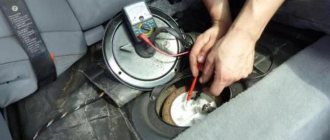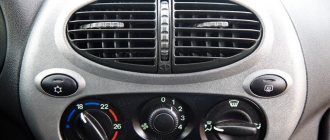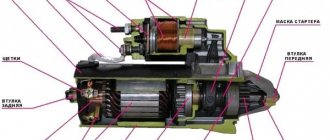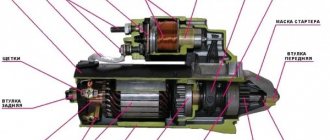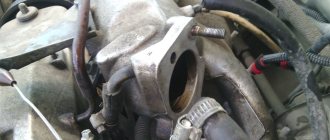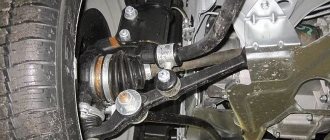Common Causes
As you know, the VAZ 2110 is equipped with two types of engines - with 8 and 16 valves. There are several main, most common reasons that cause this overheating of power units.
- Low coolant level in the system
- Failed thermostat
- Faulty radiator cooling fan
- Failed power unit temperature sensor, etc.
Let's look at each of the reasons and ways to resolve these problems separately.
Tens engine
Low coolant level
Coolant plays a huge role in the operation of the cooling system. A special substance, namely antifreeze or antifreeze, is poured into the expansion tank.
Related material:
— Replacement of coolant VAZ 2110
In a normal situation, the level of the coolant solution should be at the level of, or rather the MAX marks on the tank body. This indicates that the container is approximately 50-60 percent full.
If there is no such mark on the tank, refer to the clamp. The liquid should reach its upper edge.
- If the engine overheats, try simply adding the missing amount of coolant so that it is at the optimal filling level.
- If you have not changed the coolant for a long time, it is better not to add new coolant, but simply replace it completely with new coolant.
- When choosing between antifreeze and antifreeze, most VAZ 2110 owners prefer the first. And mainly due to the financial availability of antifreeze. But in practice, antifreeze is better . One of its most important advantages is that the substance does not freeze in severe frosts. For individual regions of our country, this is a key factor in the choice of coolant.
Thermostat
Another reason for engine overheating is a stuck thermostat valve. If it remains in the closed position and does not open, the coolant will move only along a small circuit. As a result, this will lead to strong heating of the power plant. Overheating itself threatens with very, very serious consequences.
Such a malfunction can manifest itself at the most inopportune moment - on the road. You are unlikely to be able to carry out high-quality repairs on the side of the road. But you can try one method - knock on the thermostat housing. Often this allows you to return the device to its functionality for a while. This way you can get to your own garage or the nearest service station. There the thermostat has already been replaced with a new one. There is no point in repairing it. If he failed once, the situation will certainly repeat itself soon.
Related material:
— Replacing the thermostat on a VAZ 2110, how to check and which one is better to install
Thermostat in the engine
temperature sensor
A temperature sensor is necessary in order to respond to changes in engine heating. When a preset point is reached, the sensor is triggered and turns on the cooling fan.
If this device malfunctions, the power unit overheats because the fan does not activate. Consequently, the temperature does not fall below critical levels, but continues to gradually rise.
Related material:
— Coolant temperature indicator sensor for VAZ 2110
If you encounter such a problem on the road (most often the engine overheats when you are in traffic jams, since the engine is running and there is no flow of cooling oncoming air), try to get out of the jam as quickly as possible and find a free section of the road.
Accelerate during the free stretch and then begin engine braking. This will lower the temperature and prevent overheating. Under no circumstances should you regularly operate your car this way. But this is a great way to get to a garage or auto repair shop, determine the cause of the sensor failure, and then replace it.
Cooling Fan
The symptoms of fan malfunctions are similar to a non-working temperature sensor. That is, the engine will heat up, the indicator on the dashboard will be in the red zone.
Related material:
— VAZ 2110 cooling fan does not work
Again, while on the road, we recommend using the engine braking method. Next, head to the garage. Let the car cool down. In the meantime, go to the store for a new fan. This device for the VAZ 2110 costs about 600 rubles.
Fan problems
Other reasons
There are other equally popular reasons for engine overheating. Therefore, we invite you to familiarize yourself with all of them in our table.
| Cause of overheating | Remedy |
| Coolant level too low | Add coolant to the required level, following the marks or clamp on the expansion tank |
| The radiator is clogged or blocked | Flush the radiator. If this does not help, the unit must be replaced |
| The cooling system pump has failed (the impeller slips on its internal shaft) | It's best to replace the pump |
| The oil level in the lubrication system is critical | Add oil to the required level. If it is old, change the oil |
| The ignition timing is incorrectly set | Perform torque adjustment |
| The thermostat has failed | Replace the device with a similar new one |
| The cooling fan motor has failed | It can be repaired, but it is better to install a new motor |
When faced with such a phenomenon as engine overheating, do not rush to send your VAZ 2110 for repair to a car service center. You can find many causes of overheating with your own hands and deal with them yourself. Service station services are not cheap these days, unfortunately.
Loading …
Why is half the battery cold?
When the radiator is not connected correctly.
The main reason why the battery is half cold may be that it is connected incorrectly. According to the rules for installing heating equipment in a heating circuit, the pipe supplying hot coolant must be connected to the top of the battery. The cold pipe or return, on the contrary, is to its lower part. Also read: “Radiator brackets.”
How can we explain this?
You need to take into account the laws of physics and remember that hot water is much lighter than cold water, and therefore is located in the upper part of the heating device. Gradually releasing its thermal energy to the surrounding air, the coolant cools down. Its density, and hence its weight, increases. He goes down. That is why often half of the battery is cold and half is hot.
In any case, if the radiator is half cold, you need to seek help from a specialist rather than try to solve the problem yourself. This can lead to equipment damage or injury.
Low coolant temperature.
The heating device was installed correctly, but still half of the battery is cold. What to do in this case? Very often, especially in frosty weather outside, the coolant enters the heating circuit at an insufficiently high temperature. Giving up heat to the heating element, it cools down completely. This is why the effect of a cold radiator from below is created.
Contamination inside the heating device.
Debris, rust, as a result of corrosion of the inside of the heating circuit, can lead to the fact that the batteries are half cold. What to do in such a situation? Before the start of the heating season, especially if the thermal distribution was organized several decades ago, it is necessary to clean the radiators. To do this, a locksmith from the relevant service is called and he performs all the work.
Things are worse if the radiators do not heat up after the start of the heating season. In this case, the riser of an apartment building or the heating circuit of a private building is completely taken out of service. After all, it is possible to remove contaminants from the radiator only when there is no coolant in it.
Air jams.
They may be the reason why half of the battery is cold. It is easy to check their presence if the supply pipe and return pipe of the heating element are equipped with ball valves or thermostats. They are simply blocked. Then the upper tap is opened while the lower one remains closed for only 10-15 seconds. If extraneous sounds and gurgling are heard when the coolant enters, there is air inside the heating element. It prevents the free circulation of hot water, so half of the battery does not heat.
The problem can be solved by simply bleeding the air. For this purpose, heating devices are equipped with a Mayevsky tap or an ordinary tap in the upper part. A container for collecting hot water is first installed under the locking mechanism. The Mayevsky tap opens and remains in this position until all the air leaves the heating device. The process is accompanied by spraying hot water under pressure. That is why it is recommended to cover the tap with a cloth.
The cross-section of the supply pipe is narrowed.
The heating element is installed correctly, it is new and there is no air inside, and the battery is half cold. Reason: a thermostat or tap with a narrowed flow area is installed. What does it mean? Through a pipe with a narrowed cross-section, half the coolant enters the radiator. As a result, the speed of water movement in the radiator decreases, and therefore the temperature of its surface decreases.
What needs to be done?
Dismantle the taps in front of the heating element. Before choosing a new device, be sure to consult a specialist. He must calculate the required cross-section of the valve, which will not affect the movement of coolant in the circuit.
Full room heating
The air temperature in the room will always be low if half of the radiator is cold, half is hot. The reason for this may be improper installation of the radiator, the presence of a tap in front of it with a narrowed cross-section, dirt and air inside the heating element. Any problem can be resolved if you seek help from a specialist. It is not recommended to carry out repairs yourself, as this can lead to equipment failure or injury.
>
Diagnostics using ODB-2 scanner
The general technical condition of the car can always be checked using a personal diagnostic car scanner. Of the options available on the market, we recommend paying attention to the Korean-made scanner Scan Tool Pro Black Edition. This model is perfectly compatible with most domestic and foreign cars.
A special feature of the device is comprehensive car diagnostics. Unlike analogues, this auto scanner is capable of diagnosing not only the engine, but also ABS, gearbox, transmission, airbag, air conditioning system, etc. The device is also great when used as an on-board computer: in real time it displays speed, revolutions, readings from all available sensors, oil pressure, temperature and much more.
VAZ engine overheating. Causes and consequences
Hello dear readers!
Many car enthusiasts understand: if the engine overheats, nothing good can happen.
Let's figure out what can happen when overheating and why the car overheated, using the VAZ 2110 as an example.
In principle, I do not repair domestic cars, except when friends ask. So it was actually my friends who came to me with this problem. They say it was overheated, the coolant went into the oil, and an emulsion appeared on the oil filler cap. We unscrew the spark plugs and see the presence of coolant in cylinder 3. There is nowhere to go, you need to remove the cylinder head.
They removed and checked the cylinder head, the curve (more than 2 dozen). We send it for milling, and in the meantime we begin to find the cause of overheating. Checked the thermostat - working. We noticed that the radiator was completely clogged - we cleaned it. And they made the assumption that the overheating was due to a clogged radiator.
We take the cylinder head from the milling machine, wash it, install it, change the oil and filter and bleed the cooling system. But that was not the case. It gets hot and doesn't pump. We notice that there is no movement of coolant and we decide to remove the pump (coolant pump).
I assumed that the impeller had turned or the blades had rotted. But what was my surprise when we didn’t find the impeller at all! It was at night, fortunately VAZ was full of spare parts and there were 24-hour stores too.
As a result, the pump is replaced and the car is ready for battle.
Thank you for your attention, have a nice day!
Source
How to determine if the engine is overheated
At first glance it seems very simple - according to the indicators of the engine temperature device, or - sensor. This is true, if not for one thing - novice motorists are so captivated by the road situation around them that they look at the instrument panel only in one case - how much fuel is left. Experienced motorists, on the contrary, due to their confidence in their abilities, also do not look at the car’s dashboard. And as a result, a situation often arises that overheating is detected when the engine temperature has long exceeded permissible limits, and irreparable damage has been caused to the engine. It is irreparable overheating that is one of the most complex malfunctions, which leads to very serious consequences. But more on that later.
But there is a way that will not let you miss the moment of overheating. This is problematic in a traffic jam, and is not always clearly present, but here’s what you should be aware of:
As soon as the engine temperature exceeds the permissible norm, when you sharply press the gas pedal, or when accelerating the car, even slightly, detonation knocks are clearly heard, which are popularly called “tapping fingers.” This is not true, but everyone knows this definition. If you hear such a sound, there is a 99% chance that the engine has overheated, and action must be taken.
Detonation knock is a loud metallic knock, the frequency of which coincides with the engine speed. You've probably heard such sounds when refueling with low-quality fuel. I personally don’t know where the concept of “tapping fingers” came from. But the real reason for such knocking noises is a disruption in the fuel combustion process. What you hear is nothing more than explosions of the fuel mixture. During normal engine operation, the combustion process is controlled, as soon as one of the operating parameters is violated, the process goes out of control and combustion turns into an explosion. Hence the concept - detonation (from the word detonate - explode) knocks. When the engine overheats, this is the first sign.
What is the permissible engine temperature
Before continuing the conversation, let's define what is normal temperature and what is overheating. There is no one-word answer, but there are general rules. The engine temperature is within 85-95 degrees Celsius, which is working. Engine temperature up to 100 degrees is acceptable. This means that a short-term increase in temperature to 100, sometimes up to 105 degrees is allowed. Just for a short time - up to 5 minutes. Engine temperature above 105 degrees Celsius means overheating and action must be taken.
The engine of a VAZ 2110 is overheating and what should I do?
VAZ 2110 marked the beginning of a whole family of cars. Some of them are still in production today. This model range is characterized by high reliability and relative simplicity of execution, which is one of the main reasons for the high popularity of the car. However, long-term operation has revealed a number of significant shortcomings. One of them is the cooling system.
It works great on a relatively new car, however, as soon as the service life exceeds 10 years, malfunctions appear in its operation. They ultimately manifest themselves in the same way. The arrow of the device indicating the temperature invariably creeps up. There may be several reasons why the VAZ 2110 engine heats up, and this problem requires detailed consideration.
What to do if your car overheats in a traffic jam
When driving a car for a long time in a lower gear, the engine operates with increased power, which in itself leads to overheating. Add to this the lack of counter-flow of air necessary to cool the radiator. What to do? The main thing is not to panic. Short-term overheating is not terrible, but if you see that the car is not cooling down, it’s time to act.
- Important - do not turn off the engine unless absolutely necessary. Exactly - without extreme. A stalled, overheated engine is an almost 100% guarantee of repair. It will take quite a long time to describe what is happening in the engine in this case (rotating the liners together with the crankshaft, when the engine is subsequently started - the least of the possible troubles), just take it on faith.
- Important - do not think about pouring water on the engine or pouring cold water into the radiator. The result is the same - repair. Moreover, you can try so hard that you cannot do without replacing the block and cylinder head. Another “beauty” of cold water is microcracks inside the block. Finding and eliminating will be very, very difficult, if not impossible. The car has overheated - try to pull over to the side of the road. If it doesn’t work out, don’t panic and don’t pay attention to those around you – it’s important for you to save the engine.
- Stop at idle, turn the heater on full, and wait. If after 5-10 minutes the situation does not improve, turn off the engine. It’s a good idea to open the hood; the main thing in a panic is not to forget to set the car’s parking brake.
- The only reason to turn off the engine right away is clouds of steam coming from under the hood. Most likely, the cooling pipe has burst, and further operation of the engine will only worsen the situation.
Car cooling system
The cooling system is made according to the classical design. The coolant circulates in large and small circles. Its transition from one circle to another is carried out automatically using a thermostat. The antifreeze is cooled in a radiator, which is made of aluminum for better heat transfer.
To prevent engine overheating during long-term operation in low gears, the car is equipped with a fan that turns on automatically when the temperature reaches a certain value. The main causes of malfunction of the VAZ 2110 car:
- thermostat failure;
- the fan does not work;
- airlock;
- coolant level is low;
- dirty engine surface.
Any of these reasons may cause the engine to become very hot. As a result, the machine will lose a significant part of its power.
Consequences of untimely elimination of defects
Not all drivers realize what consequences can be caused by an engine overheating, and continue to drive with a constantly running fan or frequent overheating. So, the consequences of strong engine heating are divided into 3 stages, which are worth considering separately.
Slight overheating
If the engine overheats for up to 10 minutes, the consequences may be minor. Thus, cracks will appear in the pipes of the cooling system, the temperature sensor will fail, the oil scraper rings will become deformed, and the valve and camshaft seals will melt. Also, the valves will burn out, and oil will enter the combustion chambers, which will be marked by the release of black smoke from the exhaust system.
Consequences of slight overheating, namely burnout of valves.
Significant overheating
With significant overheating, deformation occurs, or rather deflection of the cylinder head. To eliminate these consequences, you will have to dismantle the cylinder head and submit it for surface grinding. Thus, it turns out that the block head is subject to major repairs.
Burnout of the piston group due to significant overheating Measuring the deflection of the cylinder head using a ruler
Severe overheating
With severe overheating, the walls of the cylinder block become deformed and burn out, causing melting of the piston group, deformation of the connecting rods, or even breakage of the crankshaft. Thus, the engine cannot be repaired, since usually the walls of the power unit collapse and their restoration is impossible.
Burnout and deformation of pistons after severe overheating Melting of the walls of the cylinder block after overheating
What not to do when the engine is boiling
After stopping and opening the hood, many drivers try to eliminate the causes of boiling, not always understanding the process.
Under no circumstances should you open the cap of the expansion tank or radiator . When boiling, that is, significant expansion of the coolant and its transition to a gaseous state, the pressure in the system rises sharply. Opening the plug provokes the release of a significant amount of hot coolant - burns to your hands and face are almost inevitable! At the same time, it is worth taking into account a technical point - liquid leaves, which is designed to equalize the temperature, reducing it in the hottest places.
Do not pour water on a hot engine . A sharp change in temperature can lead to microcracks, which will manifest themselves later, and to cracking of metal parts. But to speed up the cooling process, you can water the radiator.
Solving key difficulties with a radiator and how to deal with problems
If you start to wonder: “Why is the heating radiator in the room at the top hot and cold at the bottom?”, then it’s time to take the necessary measures without delay.
Properly connected battery
To determine the cause, follow the following algorithm:
- it is necessary to check the accuracy of the pipe connections;
- look at the radiator itself;
- release the air and clean the device;
- it is necessary to check the condition of the valves for adjustment;
- look through the pipes;
- the pump needs to be checked.
Cold batteries, possible reasons why the radiator does not heat
The initial stage requires checking the correctness of the connection. First, estimate the temperature of the pipe section at the bottom of the radiator. If the device was connected incorrectly, the lower section of the pipe will be hot. To solve the problem, you need to turn off all the pipes and reconnect them according to the above principle. If you do everything correctly, the lower section of the pipe will be barely warm.
Very often, an air plug will appear in the radiator, which interferes with the normal heating process of the element. In order to solve the problem, the device must have an air vent or a separate seal for releasing air. To purge, you need to close the air supply, fully open the drain and release all the air. Afterwards, the tap must be returned to its previous position and the system valves must be turned. In most cases, this procedure gives the desired result.
If the system is equipped with an adjustment valve, then the problem may lie there. Remove the faucet and inspect it carefully. If you see a narrowing of its end, you will need to return the part to its original diameter using pliers. Most experts advise replacing the faucet immediately in order to increase the effective operation of the system.
If there is no tap, then most likely the problem is hidden in the pipes. We recommend removing the channels with a specialized removable wrench and cleaning them from corrosive damage and other contaminants. If the pipes are no longer suitable for use, replace them with new ones.
Often there is no high pressure in the system due to its design properties. You should find out about this when you buy a living space or a private house. To increase this indicator, change the outdated pump or purchase one if there is no pump as such. This will increase the speed of movement of the coolant and ensure more efficient operation of the entire system.
Thematic publications:
The heating radiator does not warm up completely!
Heating scheme of a one-story house with forced circulation
Why does the pressure in the heating system decrease?
The heating radiator is hot on top and cold on the bottom.
Thermostat and fan malfunctions
A symptom of a faulty thermostat is a sudden increase in temperature for no apparent reason. That is, the car engine was operating in normal mode, there was no long standing in traffic jams or driving in first gear, and the instrument needle was close to the critical mark. Why is this happening? The fact is that, as a rule, the thermostat gets stuck in the closed position.
In this case, the liquid continues to circulate bypassing the radiator, which is not enough to cool the engine. Determining whether the thermostat is really at fault is very simple. It is necessary to warm up the engine to a temperature of 90 °C. Now you should evaluate the temperature of the pipe that goes to the radiator. If it is cold, the thermostat must be replaced.
Unlike the previous case, engine overheating is preceded by prolonged operation in low gears. In this mode, the VAZ 2110 radiator does not have sufficient airflow and when the temperature reaches 95 ° C, a sensor is triggered that turns on the fan. If this does not happen, engine overheating is inevitable. Such damage is complicated by the fact that faults, in addition to the fan itself, can occur in its power supply circuit.
As a special case, a blown fuse should be mentioned. In addition, the sensor itself may fail. This is why it is so important to correctly identify the faulty unit. You can do this as follows. It is necessary to close the contacts of the sensor; it is installed on the radiator. Be careful when performing this operation. The engine must be turned off and the ignition turned on.
If the fan motor starts to spin when the contacts are closed, the sensor is faulty. If not, then the problem may be in the fuse and you need to check it. If it is in good working order, further repairs require skills and the presence of a special device, so it is better to contact a specialist.
The engine does not reach operating temperature
You can monitor the temperature readings of the power unit directly from inside the car. The dashboard of all modern cars has a small information field, usually round or semicircular in shape, showing the driver the coolant temperature readings. This is the device that gives an idea of the temperature conditions in which the engine is operating at a given time.
If the temperature gauge does not reach 90 degrees during a long trip, you should seriously think about finding the cause of the deviation from the normal operation of the power unit. It is not recommended to delay its diagnosis, because prolonged operation of the motor in this mode will lead to wear of its internal components.
The fact is that the electronic control unit, which is popularly called the “brains” of the car, recognizes an engine that has not reached the nominal temperature as cold, and therefore the fuel system injects an over-enriched mixture.
Air lock and coolant level
In this case, overheating is preceded by some action with the coolant. This could be draining it for repairs or completely replacing it. An air lock formed in the system prevents normal circulation.
You can try to get rid of it by slightly raising the front wheels of the car. To do this, the car must be placed on a hill, after which it must be allowed to idle. If this does not help, then you need to do the following:
- remove the return pipe from the throttle assembly;
- it is necessary to fill the reservoir with coolant;
- start the engine and wait until antifreeze runs out of the remote control fitting, then plug it with your finger;
- Now you need to wait until the liquid comes out of the hose, and then put it in place.
Here it is appropriate to say one more thing. The systematic formation of air jams can be associated with a very unpleasant malfunction - damage to the cylinder head gasket. But this requires the intervention of specialists and can seriously hit the wallet.
Overheating of the VAZ 2110 engine can be caused by a lack of coolant. This can happen for natural reasons, due to its evaporation or, more often, in the event of a leak. Over time, the tightness of the seals is broken and rubber parts lose their elasticity. All this leads to antifreeze leakage. If the problem is not corrected in time, it can lead to serious damage to the power unit.
A dirty surface is a common cause of engine overheating. It's no secret that power units whose mileage has exceeded 200,000 km are usually covered with an oil film on which a thick layer of dust settles. This impairs engine cooling by air flows that circulate in the engine compartment.
To exclude such a development of events, it is necessary to carefully seal all connections of the power unit. In addition, you need to systematically remove oil stains from it. In addition to the engine, the radiator itself may become dirty. This, naturally, will also worsen cooling, and the motor may begin to get very hot. In this case, it is necessary to carefully blow out the radiator with a compressor.
The engine of the VAZ 2110 car has a simple design and a long service life. However, we must not forget that for normal operation it requires appropriate care and systematic maintenance.
Source
The air in the cabin does not heat up for a long time - what is the reason?
Another big problem with warming up a car for a long time in winter is that it takes too long for the air in the cabin to warm up. You have to drive with terribly cold air from the air deflectors, scrape ice off the glass in the cabin and encounter various other troubles. Therefore, solving this problem is often a priority
It is worth paying attention to several possible reasons for this unpleasant effect:
- general problems with warming up the engine, which we discussed above, because if the fluid is not warmed up, then cold air will enter the cabin, this is an inevitable consequence;
- blockage in the cooling system - there may be air pockets in the stove itself, which do not in any way affect the quality of operation of the rest of the system; they can be eliminated at service stations;
- problems in the heater radiator - often the radiator itself is the cause of problems, it can be clogged, dirty inside or outside, which causes the effect of cold air in the cabin;
- clogged air ducts - often the problem of foggy glass and cold in the cabin is connected, it is worth cleaning the air ducts and inspecting them by removing the front panel and other parts in the cabin;
- broken switches and regulators - often car owners come to service stations who do not suspect that the temperature in the cabin is cold due to a non-functioning temperature control knob.
These are the unusual reasons that can occur when the interior is poorly heated. As a rule, such problems also include fogging and icing of the windows in the cabin, terrible stale air during a long trip, unpleasant odors, high humidity and even dampness. Such effects will clearly not benefit your car, nor will they provide a pleasant experience when using the vehicle. So you should get rid of them as soon as possible.
Watch a video on how to check the thermostat's operation:
Prevention
From time to time, you should prevent engine overheating in order to avoid unpleasant situations in the future. In terms of costs, this costs little money, but in the end it can save the engine from breakdown. You can identify the “weak link” by eliminating, gradually checking suspicious parts for malfunction.
In addition, overheating of the engine can occur if the wrong mode of operation of the motor is selected. For example, if you constantly drive only in lower gears and at high speeds, then the likelihood of the engine boiling increases, especially if there are deviations in the operation of the cooling system. In the cold season, some errors are not affected by low temperatures, but this does not mean that engines boil only in the summer.
content .. 14 15 16 17 ..
Heating system efficiency
- The main reasons for uneven heating
- How can this be dangerous?
- Ways to solve the problem
The main reasons for uneven heating
Batteries are an integral element of the room heating system, and the comfort of operation of residential and public buildings or various industrial buildings depends on its serviceability.
The most common reasons for uneven heating of heating radiators are: insufficient power of the circulation pump;
- failure to comply with slopes and angles during the installation of the pipeline system;
- incorrect thermostat mode; air lock;
- battery distortions.
Correct calculations of the power of the heating boiler, as well as commissioning of the heating system, are of no small importance. Please note that a slight temperature difference between the lower and upper parts is not a deviation. You should worry about a significant decrease in heating, it negatively affects the efficiency of the radiator
You should worry about a significant decrease in heating, it negatively affects the efficiency of the radiator
Please note that a slight temperature difference between the lower and upper parts is not a deviation. You should be concerned when the heating decreases significantly; it negatively affects the efficiency of the radiator.
How can this be dangerous?
The uniform heating of radiator batteries directly depends on the balance of the speed of the coolant and its temperature regime.
Incorrect operation of the heating system can cause:
- quite strong and unpleasant noise and vibration;
- disturbances in the acid-base balance of the thermal fluid;
- increasing the corrosive effect on heating elements;
- noticeable reduction in service life, as well as failure of batteries.
Ways to solve the problem
Not all heating system problems can be solved on their own. However, there are ways to bring radiators into working position.
To eliminate uneven heat output, you must perform the following steps:
- Bleed air from the heating system.
- Install an automatic air release valve.
- Install a circulation pump of sufficient power.
- Adjust the bypass.
It is important to annually flush the radiators and core, which very often become clogged during operation. If you cannot achieve uniform, stable heating of the radiator batteries on your own, then you should not delay in inviting qualified plumbing workers who can cope with problems of any level of complexity. published by econet.ru. If you cannot achieve uniform, stable heating of the radiator batteries on your own, then you should not delay in inviting qualified plumbing workers who can cope with problems of any level of complexity. published econet.ru
If you cannot achieve uniform, stable heating of the radiator batteries on your own, then you should not delay in inviting qualified plumbing workers who can cope with problems of any level of complexity. published econet.ru
If you have any questions on this topic, ask them to the experts and readers of our project here.
Insufficient coolant level
In the expansion tank of your car, the level of coolant should be almost equal to the half of the tank. If you look at the mark, it turns out to be the top mark on the tank body with the MAX mark. If there is no such mark, then most likely it will be located along the upper edge of the clamp.
If necessary, add antifreeze or antifreeze to the required level. It is worth noting another fact that in winter, if its level is insufficient, the stove may not work efficiently, that is, the air will not blow as hot as during normal operation of the heater.
Clogged heater radiator
The stove, like the engine, has its own radiator located directly inside the heater in the cabin. If the car does not have a cabin filter, then all the street dirt flies directly into the heater, settling on the radiator. Accumulated dust and leaves that interfere with normal operation will have to be removed manually by partially disassembling the stove body.
The stove radiator can become clogged not only outside, but also inside. This happens due to the use of low-quality coolant, mixing antifreeze with antifreeze, and also due to the use of cooling system sealants not according to the instructions. It is difficult to clean the inside of the radiator: special flushing can help, but often the radiator has to be removed and replaced with a new one.
